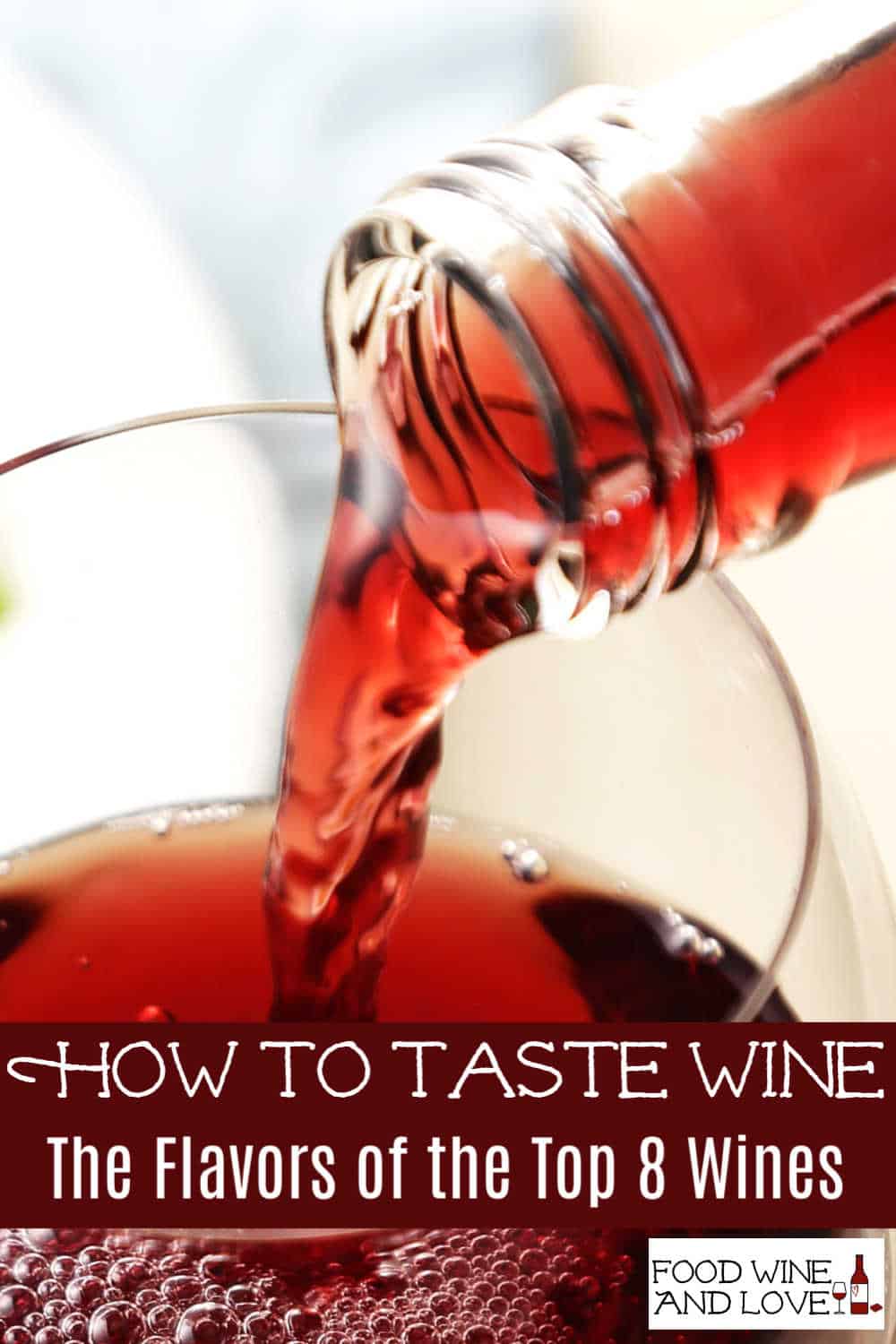Knowing The Flavors of the Top 8 Wines can certainly help you in knowing how to wine taste.
It can also help you identify what flavors you prefer in your wine as well.
The Flavors of the Top 8 Wines
Wine flavors develop from the breakdown of the ingredients and how they blend together during fermentation.
You interpret the flavors when you taste and smell the wine. Your intrepetation has a lot to do with everything that you have experienced in the past.
Interpreting the flavor of a wine is a lot like interpreting the flavor of other beverages or food that you have indulged in in your life.
For example, when you taste a baked cookie, you are tasting all of the ingredients in that cookie after they have baked together. In wine, the ingredients have fermented. The flavor of the wine is your interpretation of the fermented ingredients and how you define it according to your past experiences.
There really is a lot that can go into your wine getting its flavor.
The key to all of this is fermentation. Fermentation in wine refers to the chemical breakdown of the grapes and other ingredients by the yeast that has been added to the wine. By breakdown, we specifically mean the sugars.
There are many results from the breakdown process in your wine.
Obviously, you will get the flavor or the taste of the wine as a result of the breakdown of the sugar.
However, the sugar that is broken down is what makes the alcohol in your wine. You may recall that the fermentation process also happens in bread, yogurt and beer as well. With wine, the alcohol is trapped inside of the bottle.
You may be wondering how long it takes for wine to ferment anyway.
There are two stages of fermentation. In primary fermentation, around 70% of the alcohol results. This takes only about five days to happen.
Secondary fermentation is actually the longer stage of wine fermentation.
It takes up to two weeks for secondary fermentation to occur. While the wine may seem ready to drink, you may want to let it age as this will mellow the wine and thus, improve the flavor of the wine.
There are a number of ingredients that can lead to the flavors in your wine.
The most famous of these flavors are of course the grapes that are used. What matters with the grapes would include the kind of grape, where it has been grown, everything that has contributed to its growing process (encompassing a lot here), and thus, even what may be growing nearby the grapes.
However, there are other ingredients that can go into the flavor of your wine.
Perhaps lesser noticeable to the novice wine taster, these more subtle flavors may be present as well. Common flavors beyond grapes could include spices, vanilla, other fruits, and even wood.
As noted above, it is your interpretation of what is in the wine that helps you appreciate the flavor of the wine.
The color and the texture can also add to your interpretation. However, any residual sugar in the bottle can play a role as well.
By the way, while you are here you may also be interested in these ideas.
- How to Taste Wine. What Smell Can Tell You.
- Five Facts About Red Wine That May Surprise You.
- The Top 10 Foods For Love.
Be sure to follow me on Pinterest Facebook and Instagram.
Also, subscribe to my weekly newsletter!
The Flavors of the Top 8 Wines
Remember from what I mentioned above, that it may take some time to identify the flavors that you taste in your wine. I would recommend starting with identifying the grapes. Then you can move on to the lesser flavors that went into making your wine.
Cabernet Sauvignon
This popular red wine and is grown just about everywhere that wine is grown. It is a full-bodied red wine that is more of a dry wine than a sweet wine. However, everything depends on where it is grown however. Thus, Cabernet may seem like a sweet wine as it is so full-bodied thanks to the dark fruit in it.
Subscribe to FoodWineandLove!
Fruits- Blackberries, Cherries, Black Fruits such as Currents.
Other- Spices used for baking, Green Peppers, Oak, Green Spices.
Pinot Noir
Also a more of a dry wine rather than a sweet wine. This red wine is a lighter wine than Cabernet.
However, it is an easy wine for you to pair with foods as well.
Fruit- Raspberries, Cherries,
Other- Roses, Cloves, Mushrooms
Sauvignon Blanc
Sauvignon Blanc is possibly the most popular white wine available. It is know for its 'grassy' taste.
Also, Sauvignon Blanc is originally a French wine however, it is produced all over today.
Fruits- Lime, Grapefruit, Green Apples
Other- Grass, Jalapeno, Slate,
Merlot
This is also a very popular red wine. This dark wine is also more dry than sweet. However, it is a more 'fruity' wine which may lend us to think it is a sweeter tasting choice especially when compared to Cabernet.
Fruits- Plums, Raspberries, Cherries
Other-Tobacco, Mint,
Chardonnay
Some folks say that Chardonnay is the most popular white wine around the world. It is a dry white wine with origins in France but, grown around the world today. Thus, this is a nice choice for many folks to drink.
Fruits- Pineapple
Other- Spices for Baking, Caramel, Green Apples, Citrus such as Lemon,
Pinot Grigio
Pinot Grigio is a white wine that is lighter than other white wines. However, Pinot Grigio is also a dry yet flavorful thanks to the fruit in it.
Fruits- Citrus such as Lemon, Pears, Green Apples
Other- Flowers
Zinfandel
The grapes used in Zinfandel are black-skinned and native to California making this a popular wine in the US.
White Zinfandel is what I refer to as a 'beginner' wine. It is a sweeter wine that is relatively inexpensive and readily available.
Red Zinfandel is a more complex wine made from a darker grape. However, it is bolder in taste yet- lighter in body than red wines.
Fruits (may depend on the specific Zinfandel) - Raspberries, Blueberries, Blackberries, Cherries.
Other- (may depend on the specific Zinfandel) Spices for Baking, Licorice, Jam, Black Peppers.
Syrah
Syrah and Shiraz, are one and the same as Shiraz comes from Australia.
Fruits- Blackberries, Plums.
Other- Mint, Bacon Fat, Cocoa.
Now you know what to look for the next time you go wine tasting.
The wines that are listed above are most likely the wines that you may see when you try different wines.
However, your interpretation of flavor may be subjective as well.



